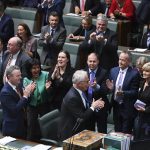On Rainbow Street
Seven years after the Northern Territory Emergency Response – the Intervention, as it came to be known – many communities are still struggling. Xenia Girdler tells the story of the remote East Arnhem community Ngukurr.
Sitting on a hill, rising up from the banks of Roper River is the remote East Arnhem community of Ngukurr, 70km inland from the Gulf of Capentaria – there are days when they sometimes feel a sea breeze.
Ngukurr is home to around 2,000 people. Like most communities in this part of Australia it suffers for its isolation.
There are 21 clans and 7 language groups in Ngukurr. Unrest is rife and the issues workers are faced with day in and day out rival that of the most impoverished developing country.
Here people are so generationally disenfranchised that the lack of hope, choice and self-efficacy screams through me – like white-hot noise. And it’s not about money.
In June 2007 the Federal Government launched its Northern Territory Emergency Response – the Intervention, as it came to be known. This initiative was to keep children and women safe and create opportunities for change. So why is it that seven years later communities continue to stumble and fall?
Millions have been spent. In some kind of blind frenzy, dollars have swirled about the heads of Aboriginal people – landing where the government of the day says it will. With limited consultation and even less involvement, people are simply “done-to”, over and over again.
Just before Christmas a colleague and I grabbed a ride on the GP plane and flew to Ngukurr to catch up with some students and visit the local health clinic. And on our way back to the airstrip, we also received a guided tour of town.
People’s access to the basics are limited. Employment opportunities are scarce – as is motivation. The community has two pools but they are rarely open because no one wants to patrol them. The day we flew in it was 46 degrees and humid almost beyond measure. The pools were closed until late afternoon when they managed to find a willing staff member. Just for an hour and a half.
As the tour of Ngukurr was drawing to a close, our guide swept his hand to the left and announced “And here we have Rainbow Street.” I turned to see a collection of luridly painted brick buildings. Small windows, no verandahs, not anything which I would consider a building in this harsh landscape might require. Our guide went on “These houses were built after the intervention. To ease the overcrowding. They were built at a cost of $795,000 each. 9.8 million dollars all up. And you know how many extra rooms were created in total?” He paused for effect. “Eight.”
My colleague and I went silent – it wasn’t that I had nothing to say. I simply did not know where to start. The outrageous cost. The appalling design. The utter waste.
I commenced by asking (even though I was sure I knew the answer) if the community were consulted about the design and involved in the building. Of course they weren’t.
But what I then discovered made me want to cry. A local company had, around the same time, built two houses in consultation with the people who were going to live there. The houses cost roughly $250k each to construct. They had verandahs – large and wide and facing the right way to remain cool in summer but catch the sunlight in the at-times bitterly cold dry season. They were designed and built to support the way people wanted to live. The General Business Manager took one look at these homes and ordered for them to be torn down. And they were – because they were not regulation.
So when I hear people talk about the money, money, money – I need to shout out: It’s not about the money. It’s about what the government chooses to spend the money on. And I need to re-tell the story of Rainbow Street, Ngukurr. To anyone who cares to listen.
Xenia Girdler is Program Coordinator of VET Alcohol and Other Drugs and mental health programs, is an award-winning leader in design and implementation of student-centred, industry-led programs in Melbourne and the Northern Territory. Xenia’s professional experience, whilst traversing many industries, holds common themes of creativity and innovation. During her years working in the community sector she became noticed as an engaging public speaker and educator. Currently, Xenia’s programs cover pre-vocational and workforce development Certificates and Diploma’s in Melbourne and Katherine, Alice Springs and the Remote Aboriginal Community Ngukurr in East Arnhem Land.












Max Thomas
April 29, 2015 at 12:43 pm
On Rainbow Street
Xenia, I think the really sad part of all this is that few would be surprised by your description of 'Rainbow Street'. Some decades ago, indigenous Australians were involved in designing some 'experimental' houses suited to their needs. In other words, the houses reflected a culture that evolved in response to the environment in which the people lived for so long. Winston Churchill said: "we shape the house, thereafter it shapes us." It follows that if assimilation was the policy of government, housing for indigenous people would have to conform with the bureaucratic application of such a policy.